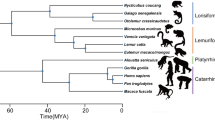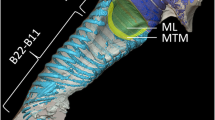Summary
It is generally supposed that the elongated, often coiled tracheae of many species of birds are adaptations for the production of loud, penetrating calls. A corollary supposition is that the acoustic effects are produced by the resonant properties of the elongated tube, with the birds being analogized to a wind instrument. We have experimented with several species of cranes possessing different degrees of tracheal coiling. Regardless of the degree of coiling, all cranes can utter extremely loud calls using remarkably low driving pressures. Neither surgical modifications of the trachea nor changing the respiratory gases to helium-oxygen produced consistent changes of voice that could be unambiguously attributed to changes of tubal resonances. However, shortening the trachea markedly reduced vocal intensity, the degree of reduction being roughly proportional to the degree of shortening. Although some of that reduction may derive from an increased impedance mismatch at the external aperture of the tube, and some from a decreased radiation directly from the hard walls of the trachea, these explanations scarcely account for the dramatic effects we observed. We, therefore, hypothesize a more unusual mechanism: The tracheal coils that are embedded in the sternum serve a function analogous to the bridge of a stringed instrument, transmitting the vibrations of a tiny sound source to a large radiating surface, the sternum. The sternum then vibrates against the large internal air reservoir of the avian airsac system. As it has a complex shape, the sternum will have many resonances and will respond to many frequencies; as a solid oscillator, its resonances will not be greatly affected by low density gases. Hence, we suggest that cranes and other birds with enlarged windpipes are more properly analogized with a violin than a trombone.
Similar content being viewed by others
References
Archibald GW (1977) The unison call of cranes as a useful taxonomic tool. PhD Dissertation, Cornell University (Univ Microfilms Int 7728183)
Bech C, Johansen K, Maloiy GMO (1979) Ventilation and expired gas composition in the Flamingo,Phoenicopterus ruber, during normal respiration and panting. Physiol Zool 52:313–328
Bernd R (1938) Intrasternale Trachealschlingen bei Vögeln. Morphol Jahrb 82:27–119
Brackenbury JH (1977) Physiological energetics of cock-crow. Nature 270:433–435
Brackenbury JH (1978) Respiratory mechanics of sound production in chickens and geese. J Exp Biol 72:229–250
Brackenbury JH (1979) Power capabilities of avian sound-producing system. J Exp Biol 78:163–166
Clench MH (1978) Tracheal elongation in birds-of-paradise, Condor 80:423–430
Dunker H-R (1971) The lung air sac system of birds: A contribution to the functional anatomy of the respiratory system. Springer, Berlin Heidelberg New York
Forbes WA (1882) On the convoluted trachea of two species of manucode (Manucodia atra andPhonygama gouldi); with remarks on similar structures in other birds. Proc Zool Soc (Lond) 24:347–353
Gaunt AS (1983) An hypothesis concerning the relationship of syringeal structure to vocal abilities. Auk 100:853–862
Gaunt AS, Gaunt SLL (1985) Syringeal structure and avian phonation. In: Johnston RF (ed) Current ornithology 2. Plenum, New York, pp 213–245
Gaunt AS, Hetherington TH (1985) Absence of resonance modulation in non-human voices. Am Zool 25:19A
Gaunt AS, Stein RC, Gaunt SLL(1973) Pressure and air flow during distress calls of the Starling,Sturnus vulgaris (Aves; Passeriformes). J Exp Zool 183:241–262
Gaunt AS, Gaunt SLL, Hector DH (1976) Mechanics of the syrinx inCallus gallus. I. A comparison of pressure events in chickens to those in oscines. Condor 78:208–223
Gaunt AS, Gaunt SLL, Casey RM (1982) Syringeal mechanics reassessed: Evidence fromStreptopelia. Auk 99:474–494
Greenewalt CH (1968) Bird song: acoustics and physiology. Smithson Inst Press, Washington
Hesh GL (1966) Bird voices during resonant tuning in heliumair mixtures. PhD Dissertation, University of California, Berkeley (Univ Microfilms Int 67-5078)
Hinds DS, Calder WA (1971) Tracheal dead space in the respiration of birds. Evolution 25:429–440
Hunter ML Jr., Kacelnik A, Vuillermoz JR, Vuillermoz M (1986) Directionality of avian vocalizations: A laboratory study. Condor 83:371–375
Johnsgard PA (1983) Cranes of the world. Indiana University Press, Bloomington
Miller AH (1934) The vocal apparatus of some North American owls. Condor 36:204–213
Myres JA (1917) Studies on the syrinx ofGallus domesticus. J Morphol 29:165–214
Niemeier MAL (1980) Structural and functional aspects of vocal ontogeny inGrus canadensis (Gruidae: Aves). PhD Dissertation, University Nebraska (Univ Microfilms Int 8010870)
Nowicki S (1987) Vocal tract resonances in oscine bird sound production: Evidence from birdsongs in a helium atmosphere. Nature 325:53–55
Nowicki S, Capranica RR (1986) Bilateral syringeal interaction in vocal production of an oscine bird sound. Science 231:1297–1299
Nowicki S, Capranica RR (1987) Bilateral syringeal coupling during phonation of a songbird. J Neurosci 6:3595–3610
Parsons Dr (1766) An account of some peculiar advantages in the structure of the asperae arteriae, or windpipes, of several birds and the land tortoise. Phil Trans R Soc Lond 56:204–215 (From: Abridged Trans 1665–1800. Hutton C, Shaw G, Pearson R (eds) (1809) vol 12, 1763–1769:329–336)
Prange HD, Wasser JS, Gaunt AS, Gaunt SLL (1985) Respiratory responses to acute heat stress in cranes (Gruidae): The effects of tracheal coiling. Resp Physiol 62:95–103
Roberts LH (1973) Comparative studies of sound production in small mammals with special reference to ultrasound. PhD Dissertation, University of London
Rossing TD (1982) The science of sound. Addison Wesley, Reading MA
Rüppell W (1933) Physiologie und Akustik der Vogelstimme. J Ornithol 81:433–542
Schmidt-Nielsen K (1972) How animals work. Cambridge University Press, London
Schmidt-Nielsen K, Kanwisher J, Lesiewski RC, Cohn JE, Bretz WL (1969) Temperature regulation in the ostrich. Condor 71:341–352
Stein RC (1968) Modulation in birds. Auk 85:229–243
Sutherland CA, McChesney DS (1965) Sound production in two species of geese. Living Bird 4:99–106
White SS (1968) Movements of the larynx during crowing in the domestic cock. J Anat 103:390–392
Yarrell W (1827) On the trachea of birds. Trans Linn Soc Lond 15:378–391
Author information
Authors and Affiliations
Rights and permissions
About this article
Cite this article
Gaunt, A.S., Gaunt, S.L.L., Prange, H.D. et al. The effects of tracheal coiling on the vocalizations of cranes (Aves; Gruidae). J. Comp. Physiol. 161, 43–58 (1987). https://doi.org/10.1007/BF00609454
Accepted:
Issue Date:
DOI: https://doi.org/10.1007/BF00609454




